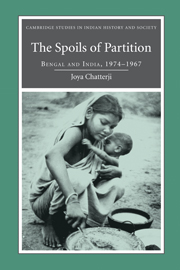Book contents
- Frontmatter
- Contents
- List of maps and illustration
- List of tables
- List of abbreviations
- Glossary
- Preface and acknowledgements
- Introduction
- Part I Hopes and fears
- 1 The devil in the detail: new borders for a new state
- 2 Swings and roundabouts: West Bengal and the new India
- Part II The Bengal diaspora
- Part III The politics of a partitioned state
- Conclusion
- Appendix
- Bibliography
- Index
1 - The devil in the detail: new borders for a new state
Published online by Cambridge University Press: 25 June 2009
- Frontmatter
- Contents
- List of maps and illustration
- List of tables
- List of abbreviations
- Glossary
- Preface and acknowledgements
- Introduction
- Part I Hopes and fears
- 1 The devil in the detail: new borders for a new state
- 2 Swings and roundabouts: West Bengal and the new India
- Part II The Bengal diaspora
- Part III The politics of a partitioned state
- Conclusion
- Appendix
- Bibliography
- Index
Summary
Attlee's statement of 3 June heralded success for the coalition of Bengal's Hindu leaders who, in the last years of the Raj, had campaigned so vigorously for the partition of their province. By decisions taken in London and in Delhi, they had won for themselves a Hindu state inside India which would be in place before the end of the monsoon. With this prize in imminent prospect, the leaders of the Hindu coalition had to turn their attention to the practical details of converting, by mid-August, their idea of a Hindu homeland into reality.
The triumphalist euphoria of the Hindu leadership, when they were faced with this daunting task, quickly gave way to more sober-sided calculations. Large questions now had to be addressed and swiftly answered. In practice, what Hindu state could be successfully carved out of old Bengal? What balance of people and territories should the new homeland ideally possess? Where should its borders be? And, most importantly, how could the would-be leaders ensure that they would get to run the new state of West Bengal? Once these questions came urgently to be considered, it became clear that the answers were interconnected and would have far-reaching implications for the new state. Evidently, the physical frontiers of the new state would bear critically upon who would run it, and defining the citizens of the new polity was the key factor in making sure that the social groups that the coalition represented would dominate it.
- Type
- Chapter
- Information
- The Spoils of PartitionBengal and India, 1947–1967, pp. 19 - 60Publisher: Cambridge University PressPrint publication year: 2007



